Introduction
Aquaculture is the worlds fastest growing
food sector and tilapia represents much
of that growth. The popularity of tilapia
continues to skyrocket. Global production
has nearly tripled since the beginning of
the decade with an estimated output of 3.7
million tons in 2010, according to the Food
and Agriculture Organization (FAO) of the
United Nations. No other fish species has
displayed such aggressive and sustainable
growth, year after year.
There are several reasons for increased
tilapia production. Tilapia can be produced
in versatile locations, water systems,
temperatures and salinities. They have
good performance characteristics such as
fast growth, a high fillet yield and low feed-conversion
ratio (FCR) as well as firm, white
fillet that makes them easy to market.
Tilapia can now be considered a commodity
item with a stable supply, demand
and price. However, the cost of raw
materials is increasing, which is increasing
the cost of production and reducing
profit margins. Further advancements
in production efficiency are required to
improve profitability, and this trend is
continually driving the industry toward
consolidation and intensification. Indeed,
FAO reports that the overall number of
fish farms is decreasing, while the size of
individual farms is increasing, indicating
the concentration of fish farms into fewer hands. This situation fosters the
emergence of production diseases
and tilapia are no exception.
Experience has shown that most intensive
fish farming operations suffer from
between six and eight major production
diseases and that these must be prevented
or controlled before the industry can
become truly sustainable. In tilapia, we
have so far identified four major bacterial
diseases: Streptococcus agalactiae,
Streptococcus iniae, Flavobacterium
columnare and Francisella spp.; one viral
disease, iridovirus; and two major groups
of parasites: the monogeneans such as
Gyrodactylus and the protozoan such as
Trichodina (Figure 1). Their prevalence and
severity depend on many environmental
factors, such as geographical location,
culture system, farming intensity, water
salinity and temperature, and on several
biological factors such as age, genetics,
nutrition and stress.
Streptococcus: An Established Pathogen
By far the most important diseases economically are those due to streptococcus. In many instances, streptococcosis does not contribute the highest mortality, but it kills large fish and, as a consequence, heavily affects the FCR, reduces marketable product and damages production and processing efficiency (Figure 2).
Major Diseases Affecting Tilapia
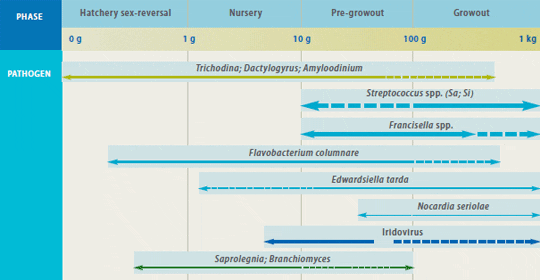
Note: Importance of the disease is roughly in proportion to the size of the arrow bars.
Some Clinical Signs of Streptococcal Diseases in Farmed Tilapia

MIDDLE: 3-gram juvenile tilapia with bilateral exophthalmia
RIGHT: Late-stage bilateral exophthalmia and corneal opacity
In 2000, MSD Animal Health initiated extensive epidemiological surveys in the major tilapia-producing regions of Asia and Latin America. We have identified over 1,000 bacterial isolates from tilapia reared at 74 sites in 14 countries to better understand the relative importance of streptococcal pathogens to the industry. As other investigations have found, these streptococcal species were the dominant bacterial pathogens, accounting for more than half of all bacteria identified. However, it is interesting that while S. iniae is the most commonly reported pathogen of fish, our data show that S. agalactiae is the more prevalent of the two in tilapia.
S. Agalactiae Biotype Prevalence
Detailed analysis of our isolates reveals
two distinct clusters that differ in a
variety of biochemical and phenotypic
characteristics. We refer to these clusters
as biotypes and differentiate between
typically beta-haemolytical classical
S. agalactiae (Biotype I) and typically
non-beta-haemolytical S. agalactiae
(Biotype II).
S. agalactiae Biotype II is considered the
most globally significant of the biotypes,
with chronic mortality in many Asian and Latin American countries, whereas
S. agalactiae Biotype I is limited to Asia
and displays acute mortality peaks, often
associated with higher temperatures.
In our epidemiological surveys to date,
26% of all streptococcal isolates of tilapia
were found to be S. agalactiae Biotype I
and 56% were identified as S. agalactiae
Biotype II (Table 1).
| Percent of Total Streptococcal Isolations from Tilapia Reared in 14 Countries | |
|---|---|
| PREVALENCE | |
| S. agalactiae Biotype I (Sa1) | 26% |
| S. agalactiae Biotype II (Sa2) | 56% td> |
| S. iniae | 18% |
Vaccine Development and Biotype Significance
Vaccines to protect against S. agalactiae
have been described by various authors,
but it is difficult to conclude from these
studies if the vaccine and challenge strain
were from the same, or different, biotypes.
To determine if our classification of the fish
pathogenic S. agalactiae has consequences
for the development of vaccines to control
this devastating disease, we conducted
a laboratory challenge to determine the ability of biotype-specific vaccines to
protect against lethal challenge with
S. agalactiae Biotype I or Biotype II strains.
Tilapia vaccinated with experimental
S. agalactiae Biotype I vaccines were
protected against lethal challenges with
virulent S. agalactiae Biotype I strains;
however, no protection was observed in
tilapia that received the Biotype I vaccine
when they were challenged with virulent
Biotype II strains. Similarly, fish vaccinated
with S. agalactiae Biotype II vaccines
were protected against lethal challenge
with Biotype II, but not with a virulent
Biotype I strain. Thus, vaccination with
biotype-specific bacterin vaccines induces
biotype-specific protection against
mortality caused by S. agalactiae.
Laboratory studies also demonstrated
that AquaVac Strep Sa, a Biotype II vaccine
ultimately developed for commercial use,
protects against S. agalactiae Biotype II for
at least 30 weeks (Figure 3).
Laboratory Efficacy Against S. Agalactiae Biotype II 30 weeks after vaccination with AquaVac Strep Sa
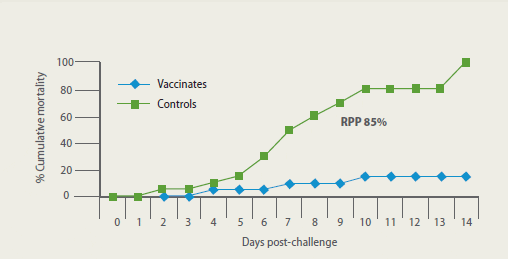
Experimental challenge with a virulent heterologous S. agalactiae Biotype II isolate RPP = relative percent protection
Field Assessment of Prototype Vaccine
Carefully controlled, field registration
trials were conducted to determine if
results in the lab would be the same in
the field with AquaVac Strep Sa, the
vaccine for S. agalactiae Biotype II.
The field trials were conducted in a lake
environment using square cages housing
~10,000 fish at a large Asian tilapia farm.
The trial was run in triplicate with three
test cohorts including AquaVac Strep Sa,
a placebo oil group and a negative,
unvaccinated control. The fish were
vaccinated at ~15 g after transfer to
growout cages from the nursery ponds.
Extensive bacteriological and virological
samplings were conducted before, during
and every month after vaccination and at
specific time points during the trial when
mortality was recorded above normal.
As per the routine growout strategy, the
trial was terminated and fish processed
after ~200 days (just under 7 months)
when they reached approxmately 1.2 kg.
Mortality, feed and water quality
parameters were recorded daily along
with the final harvest data.
Clear disease patterns emerged during the
trial in all cages, indicating that columnaris
disease or Flavobacterium columnare was
responsible for high initial mortality peaks
immediately after stocking. As the columnaris or saddle-back disease
subsided, along with the initial transport
and stocking stress, then iridovirus (a
common viral disease of tilapia in this area)
resulted in three clear peaks of mortality
(Figure 4). This mortality pattern is often
indicative of the disease and losses can
routinely be as high as 30%. As the fish
got larger, S. agalactiae and, to a much
lesser degree, S. inae were increasingly
reisolated from moribund fish in all
three cohorts.
The mortality patterns indicate that
although the incidence of columnaris
disease and iridovirus was similar in all
groups, the degree of mortality from
S. agalactiae was relatively much lower in
the vaccine group when compared to the
placebo oil and negative controls. Data
gathered at harvest substantiated that
observation: Survival in vaccinates was
80% compared to 67% survival in the
placebo and negative control groups,
representing a 13% improvement in
vaccinated fish.
Correspondingly, FCR figures were 1.86 in
the vaccinates, compared to 2.06 and 2.05
in the placebo and negative control groups,
respectively. This was an approximate 10%
improvement in FCR (Table 2).
In this trial, vaccinated fish had improved
feed intake and feed utilization; consequently,
they had improved production
efficiency performance, with 2.25 metric tons more fish harvested in the
vaccinated population compared
to controls.
Daily Mortality and Cumulative Survival in Untreated Controls
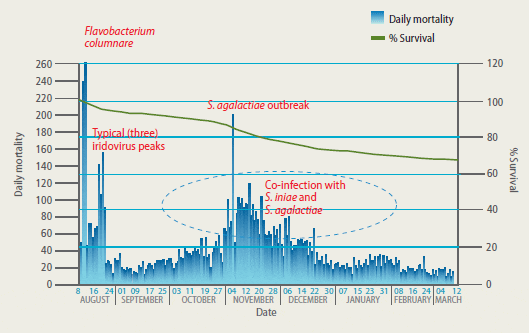
| Results from a Field Trial with AquaVac Strep Sa | ||||
|---|---|---|---|---|
| TREATMENT GROUP | % SURVIVAL | % IMPROVEMENT IN SURVIVAL | FCR* | IMPROVEMENT IN FCR* |
| Vaccinates | 80% | 13% | 1.86 | ca 10% |
| Placebo-vaccinated controls | 67% | 2.06 | ||
| Untreated controls | 67% | 2.05 | ||
| FCR = feed-conversion ratio | ||||
This well-controlled field trial clearly demonstrates that AquaVac Strep Sa is safe and efficacious when used under field conditions. Significant improvements in both survival and FCR mean an effective, cost-efficient vaccine prevention strategy is available for the industry to cope with this devastating disease.
Cross - Protection Studies
Further controlled laboratory challenge studies, using Indonesian, Malaysian, Vietnamese, Honduran, Brazilian, Mexican and Ecuadorian strains against the relative commercial vaccine, indicate that the vaccine cross-protects against multiple, geographically diverse isolates (Figure 5).
Commercial Vaccination Experiences
The success of the first large commercialscale
injection vaccination programs in
tilapia to date has been variable, as
expected. The laboratory environment
demonstrates the efficacy of the vaccine
for protection against specific S. agalactiae
challenges, and well-controlled replicate
comparison trials have been conducted
comparing control versus vaccinated tanks.
In the lab, the fish are clean and free from
disease prior to, during and in general for
3 weeks after vaccination; furthermore,
there are no other diseases present other
than that for which the vaccine is being
tested. Although the numbers are
obviously smaller in the laboratory, another
important consideration is that 100% of
the housing unit is vaccinated.
Since vaccine efficacy against S. agalactiae
and its ability to cross-protect against
multiple geographically diverse isolates
has already been clearly demonstrated
in the lab, the aim of a commercial
vaccination program is to discover the
best way to implement the vaccine
effectively under local conditions.
The initial field trials and large-scale
vaccination programs have clearly taught
us lessons on some fundamental factors
to implement before any operation can or
should embark on a vaccination program.
- Correct diagnosis: Before a commercial producer commits to a vaccination program, the underlying cause of mortality needs to be determined by a fish health specialist.
- Antimicrobial susceptibility analysis: If a bacterial disease is confirmed, a diagnostic laboratory should perform an antimicrobial susceptibility test to determine if the bacteria is susceptible to therapeutic remediation and, if this is the case, which antibiotic is most suitable to control the outbreak.
- S. agalactiae biotype confirmation: If Streptococcus agalactiae is confirmed as the primary disease, a more detailed biotype analysis is necessary to ensure the right vaccine is chosen for the right reason, because we now know that immunity is biotype-specific.
- Healthy fish: Healthy fish means that there is no sign of clinical or subclinical disease. Fish should be free of disease and stress before, during and for the first 2 to 3 weeks after vaccination. That means climatic (water quality) and housing conditions (biomass, handling, etc.) at this stage are crucial.
Efficacy of AquaVac Strep Sa Against Local Isolates / RPP = Relative Percent Protection
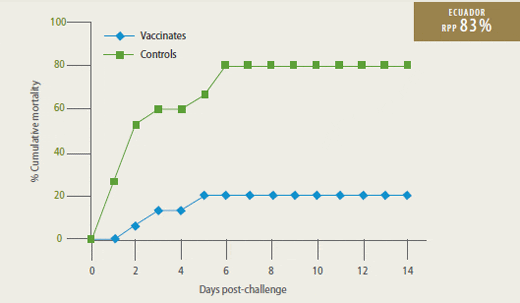
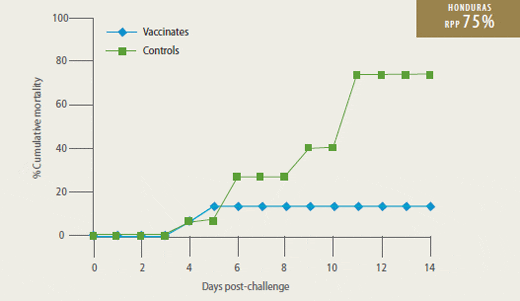
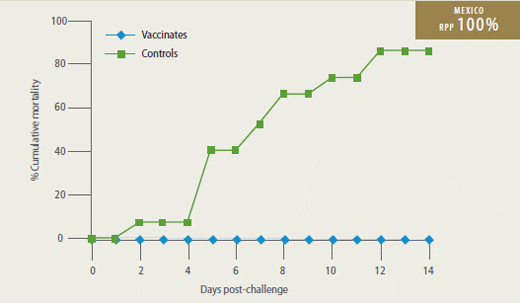
The best results are obtained in operations
where the stages of production are
separated: The hatchery, nursery,
pre-growout and growout are located in different areas with separated housing
unit employees and equipment. The
hatchery and nursery phases should,
preferably, be biosecure, well-controlled
and disease-free. This not only gives
juvenile fish the best start in life but also
allows vaccines to be administered in a
controlled environment.
There are four key components to the
vaccine program.
- Correct administration: The aim is to administer the vaccine in a consistent and proper manner so there is minimal stress on the animal and to ensure that the correct dose is given to each and every individual.
- Sufficient immune response: Correct vaccination and maintenance in a healthy state under suitable housing conditions prior to transfer will trigger a sufficient immune response before exposure to the challenge environment.
- Population protection: To achieve population protection, it is important that the entire population is vaccinated, not just a fraction of that population. The aim is to achieve blanket protection in the shortest time frame possible; this is much easier in an all-in/all-out production system, where 100% of stocked fish can be vaccinated, as opposed to gradually replacing susceptible fish with protected fish.
- Shift the balance: It is important to note that even if a fish has been vaccinated, it may still be susceptible to disease and infection depending on its health, nutritional and stress status. Therefore, a combination of good management strategies, biosecurity, housing, water quality, nutrition, sanitation, immune stimulation and vaccination will tip the balance toward disease control.
A good vaccination program will result in a rapid onset and full duration of protection. Over time, the vaccination program will have a self-perpetuating or snowball effect; with fewer sick and dying fish, there will be less bacterial shedding in the water. Less bacterial shedding in turn lowers total challenge pressure, and coupled with increasingly more protected individuals, there will be overall better population performance.
Conclusion
MSD Animal Healths extensive epidemiological
surveys of streptococcus
infections in tilapia have revealed some
startling insights about the complexity
of the disease.
Detailed analysis of our tilapia S. agalactiae
isolates suggests the presence of two biotypes that have a variety of different
biochemical and phenotypic characteristics.
These biotypes are geographically
diverse, with Biotype II being the most
prevalent in Asia and South America.
To our knowledge, there are no
obvious geographical, physiological
or environmental explanations for the
regional distribution of S. agalactiae
Biotypes I and II. Consequently, it would
be prudent to consider the possibility
that the distribution of the biotypes
may change over time, probably through
trade in live fish.
S. agalactiae vaccines are biotypespecific
and do not cross-protect. One
commercially available vaccine, AquaVac
Strep Sa, has been developed to help
protect tilapia against S. agalactiae
Biotype II. The vaccine has been fully
tested in the lab and in field situations
and has clearly been demonstrated to
be safe and effective.
If all aspects of the production system are
aligned toward good biosecurity and there
is a specific health management plan with
vaccination as its cornerstone, tilapia farms
will be able to control streptococcosis and
attain consistent production volumes.
November 2012
This article contains information on veterinary pharmaceutical and biological animal health products based on international registration dossiers. It may refer to products that are either not available in your country or are marketed under a different trade name. In addition, the safety and efficacy data and the withholding periods for a specific product may be different depending on local regulations. Consult the the regulatory and technical information on available veterinary drugs in your country.


